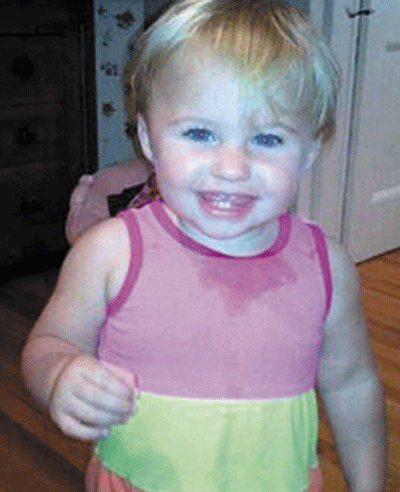WATERVILLE — The chemical police used to discover the blood of missing toddler Ayla Reynolds in her home can literally shed light on an investigation.
The liquid, luminol, can be used to detect trace amounts of blood that would otherwise be invisible to the naked eye. Even when blood is cleaned up from a surface, traces remain that can’t be seen. When luminol comes into contact with blood it glows.
Over the weekend, Department of Public Safety Spokesman Steve McCausland said investigators had found blood belonging to the 21-month-old in the home where the toddler was reported missing. He wouldn’t disclose how much blood investigators had found, but said they used luminol to find it in the basement at 29 Violette Ave.
Melisa Staples, assistant director of the New Hampshire State Police Crime Laboratory in Concord, N.H, said the chemical was first used for forensic purposes in 1937. It reacts with several materials, including cleaning products, some metals, horseradish and more, she said.
For that reason, a chemical reaction doesn’t necessarily signal the presence of blood. That determination is ultimately made in the lab.
Staples said investigators typically use the chemical toward the end of a crime scene investigation, after other pieces of potential evidence have been removed.
“It’s used in situations where, for whatever reason, the investigators may feel there’s something more that they’re missing,” she said.
When an area of interest is identified, investigators turn off the lights before introducing luminol. The scene must be dark, she said.
“When you spray it on, you see a glowing bluish light when there’s a positive reaction,” she said. “That light then dissipates, so you need to be able to photograph it right away and make your observations very shortly after you spray it on the area of interest.”
Investigators only get one chance at detecting blood with luminol. Once the two have reacted, they won’t react a second time. But, the reaction does not ruin the sample, she said.
“Luminol doesn’t effect our ability to obtain DNA results,” she said.
After investigators get a positive reaction, the next step is to get samples to the crime lab. Collecting those samples can be tricky, she said.
“It depends on what kind of surface it’s on. If it’s on a wall, sheetrock or something, I would cut it right out. When you’re talking about something you need luminol to see, it’s not something visible that you can just swab off the wall,” Staples said. “The best thing to do is completely remove the object and let the people at the lab decide the best way test it from there.”
McCausland said Saturday that several hundred pieces of potential evidence were removed from Ayla’s home, including blood samples that haven’t been tested. He also said that police found no forensic evidence to support claims that Ayla was abducted from the home.
“We think the three adults in the home that night haven’t told us everything they know,” McCausland said Saturday.
He said Monday there were six people in the house the night before Ayla was reported missing: Justin DiPietro and his daughter Ayla, DiPietro’s sister Elisha DiPietro and her young daughter, and DiPietro’s girlfriend, Courtney Roberts, and her young son.
Ben McCanna — 861-9239
bmccanna@centralmaine.com
Send questions/comments to the editors.



